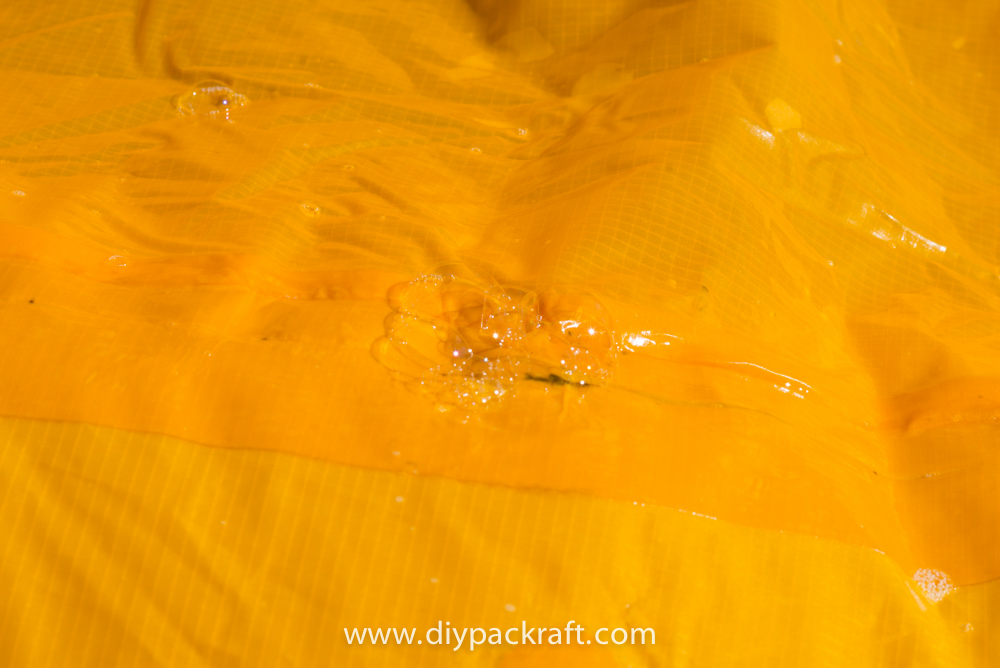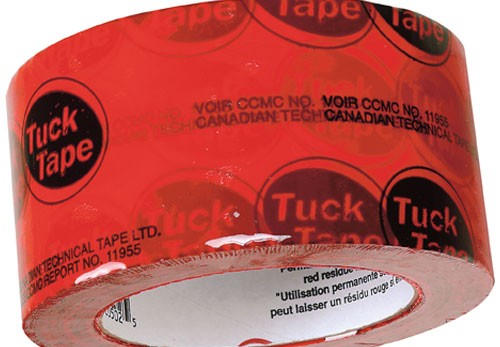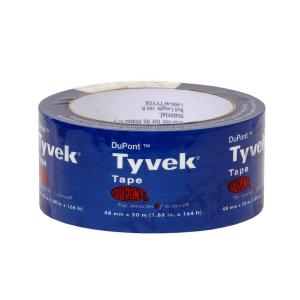For a video and more up-to-date information on this topic, visit this page.
If you’re paddling an ultra-lightweight inflatable packraft in any but the most ideal conditions, it’s almost inevitable that your boat will develop a leak at some point. Fortunately, that is not a big problem, because small leaks and even large tears are easy to repair.
Contrary to common sense, a leaky packraft is nothing to be afraid of. The volume of air inside the tubes is large, and holes in the fabric are typically small, so it takes a long time to lose so much air you can’t stay afloat. With your Boston valve positioned correctly, you can even top up the air pressure with a few breaths while you are out on the water, and even with a 1 cm (~1/2 inch) puncture in your packraft, air escapes slowly enough that you can paddle to shore long before losing buoyancy. I have paddled around a lake for an hour with two people in my packraft while it was leaking air because I was too lazy to find the hole… my passenger didn’t even notice.
Because air pressure is distributed evenly inside a packraft and it is inflated to a relatively low pressure, the fabric tends to deform around objects it impacts instead of ripping open, making lightweight fabrics much more puncture-resistant than intuition would suggest. Punctures are only likely to occur in moving-water situations where momentum shoves you and your packraft against a sharp object with a great deal of force. If you are a long distance from shore, such as crossing a fjord or large lake, there are no sharp objects nearby and you are moving relatively slowly, so there is no need to worry about puncturing your packraft there unless you stop to practise juggling knives or something equally foolish.
With all of that said, it is a good idea to keep your packraft airtight, if for no other reason than it will feel more rigid and responsive on the water when fully inflated. So how do you fix a leak?
The first step is to figure out where the leak is. Large punctures will be easy to find, but most leaks are small and can take more effort to locate. Much like fixing a punctured bicycle tube, the easiest way to find the hole is to inflate the packraft and squeeze it with your hands while rotating it around your head as you listen for the hiss of escaping air. If the environment is too loud or the leak is so small that you can’t hear it, spread some soapy water over the fabric and soap bubbles will form wherever air is escaping. In the field, if you don’t have any camp soap, you can use plain water – soap just makes the bubbles more obvious. Once you have located the leak, rinse off the soap and wipe the fabric dry.
For field repairs, the best patch material I have found is adhesive tape designed for permanently sealing vapour barrier plastic sheeting in building construction. This tape is made of strong plastic film with a very sticky waterproof adhesive on one side. It bonds very well to PU and TPU coated fabric, but can be peeled off without leaving any residue. It is available in building supply stores, but it is sold under different names in different countries – here in Canada, Tuck Tape is common; in the USA, you will find Tyvek Tape at any Lowes or Home Depot; in Finland, Kerabit Air/Vapour Barrier Tape is available; and so on. If you are unsure what kind of tape to purchase, leave a comment below and I will help you find the right tape in your country; alternatively, if you know what brands of vapour barrier tape are sold in your country, leave a comment below to help others find it. Note: avoid using duct tape – the adhesive is not waterproof.
In the field, simply slap a piece of vapour barrier tape over the hole in your packraft, reinflate it, and carry on. This tape works so well you can keep paddling for months without a “permanent” fix.
Back at home, peel off the tape, make sure the fabric is clean and dry, and plug in your heat-sealing iron. Cut a piece of your heat sealable fabric large enough to cover the hole with at least 1 cm (~1/2 inch) overlap, and round off the corners with your scissors. If you’ve built your packraft with the TPU on the outside, simply place the patch over the hole, place a piece of parchment paper over the patch, and seal it in place with your iron.
If you’ve built your packraft with the TPU on the inside, you may need to enlarge the hole before rolling up the patch and sliding it inside the tube and then sealing it in place. Alternatively, you can pass the patch through the inflation valve into your partially inflated packraft and manipulate it into place (this is not too difficult if you backlight your packraft with a lamp so you can see the patch through the fabric). Seal the patch in place with your iron, being careful not to iron past the edge of the patch.
If you have a leak where multiple pieces of fabric join together and there is no way to form a TPU to TPU bond around the hole, you may have to affix your patch with glue such as Aquaseal.



19 Comments
Zach Schiada · April 30, 2024 at 10:43 am
I used a product called Toobseal, which is a runny, acrylic based sealant. I put about half a bottle of the 32 oz in through the Boston valve, filled it up and rotated a few times. It found the leak and so far appears to have sealed well. Time will tell if it holds up well. I had previously had a slow leak that I couldn’t find, but figured it out with the toobseal. I think this would mess up a tizip if it came in contact, but this seems like an option for those like me who opted to not get a zipper. It also stains the inside fabric, which doesn’t bother me, but likely would bother others.
Matt (Admin) · April 30, 2024 at 11:59 am
That’s interesting – thanks for the tip, Zach! Did it coat the entire inside of the packraft? That might actually be a nice option for people who are looking for a bit of extra security and who don’t mind the adde weight. Cheers!
Zach Schiada · April 30, 2024 at 12:33 pm
I think so, but I’m not sure how uniform I can get the inner coating. I’ll really have to test it out on the water and give it a few days to see how effective it is. I’m optimistic, but I’ll give an update once it’s been really put to the test. The product is $55 and I bought it from Utah whitewater gear online. I also poured some into my seat since it holds air well, but not perfect. We don’t have any rain in the forecast, but I hope to battle test this out on the river soon. I can say that I purchased a top off valve from MRS that I like for inflating on the river that I used last time I took it out, but if this product works out, I’m hoping to not need to top off at all. We’ll see how it goes.
zachschiada · May 2, 2024 at 1:42 pm
Update on the Toobseal. I’m not entirely sure if it’s due to having put too much in the valve, but now my stern seam strip is starting to tear away. My suspicion is that too much of the Toobseal worked its way between the tube and seam strip fabric and maybe since it’s made to plug air leaks, wedged its way in which caused the separation. I’m not sure if it’s from of not having the seam strip welded properly too much of the Toobseal, but it’s problematic enough to possibly not recommend the product. My guess is I just applied too much and it soaked the fabric. It seems to only be on that seam strip so maybe it’s still good, but I’d recommend just being cautious and conservative with how much is applied if anyone tries out this product.
Daniel Meyer · December 10, 2023 at 5:51 am
For those that want to use glue for punctures, I use Helaplast, a PVC glue, I don’t know the name on USA, but I know it exists because I saw a YouTube Video using a PVC glue that is similar. It is not for small punctures (Aquaseal is better), but to apply a large piece of TPU it holds extremely well. I use it to add tie downs because it is at least for me much easier than using heat. I even glued none TPU side to TPU side and put whole weight on it (hanging) and the fabrics ripped apart not the glued parts.
Instructions how to use best here: https://www.packrafting.de/2011/09/tiedowns-richtig-ankleben.html?m=1
Matt (Admin) · December 11, 2023 at 9:13 am
Thanks for the tip, Daniel!
BigFatRick · August 4, 2022 at 10:17 am
Matt,
Do you have any experience repairing holes in kokopelli packrafts (the nirvana, specifically)? I have some leftover fabric from my Telkwa and a friend has a Nirvana that leaks along the seam underneath an old patch that someone else applied. I’m thinking the heat sealing technique is probably more permanent than glue patches, and I’ve read that kokopelli uses TPU. Just wondering if it’s a good/bad idea before I take a heat iron to a friend’s boat.
Matt (Admin) · August 4, 2022 at 2:01 pm
I’m pretty confident it will work fine, but before tackling the repair, try welding a small circle of fabric to an out-of-the-way spot to make sure. Cheers
BigFatRick · August 4, 2022 at 4:33 pm
Killer. Thanks man. Looking forward to putting the new spray deck on my Telkwa! I’m taking the Telkwa (sans spray deck) down the middle fork of the salmon in late August. I’ll let ya know if she pops 😂
Matt (Admin) · August 4, 2022 at 5:16 pm
Right on! Bon voyage 😀
PhilM · August 24, 2020 at 1:56 am
Hello,
Does someone know what tape could do the work in France?
Thanks
Tom · March 14, 2020 at 10:01 am
Hi Matt,
I have two questions:
-1; if I touch some adjacent parts of the TPU coated fabric with my iron while ironninng the seam strips for tube to tube attachment, or generally if I unperposelly touch some TPU with my iron and that it leaves a mark, suggesting that the TPU is affected, should I systematically apply some Aquaseal, or any type of glue to prevent a probable leak?
-2; if I iron for too long, in my case, when I attached a tube to my V3 floor, I ironned for two long and the bottom part of the floor (the one in contact with the water) has some spots where the TPU is a liltle bit melted (but still covering the nylon I think), again, should sytematicaly seal these spots to prevent possible leaks?
Thanks!
Matt (Admin) · March 19, 2020 at 8:52 am
Hi Tom, it wouldn’t hurt to apply some Aquaseal to all areas of damaged TPU. Personally, I only do so where it looks like the TPU might not be airtight – if it is only slightly melted, it is usually okay. Similarly, where I iron too long I usually do apply some adhesive to the fabric if it looks like there is any chance it might not be airtight. It’s best to apply the adhesive to the inside of the fabric in places where it will not darken the fabric (e.g. the floor) or where darker patches won’t be noticeable on the inflated packraft. If the floor fabric is damaged on the outside (bottom), I would also apply some adhesive there to protect it from abrasion.
tom · March 28, 2020 at 5:14 am
Ok perfect, and what kind of adhesive would you recommend for the melted floor where I ironed too long? For the inside of the tubes, would you use some bands of TuckTape? And use some Seamgrip for the outside (bottom) of the floor?
Thank you!
Matt (Admin) · March 28, 2020 at 3:48 pm
I’d use Seam Grip or Aquaseal for the outside of the floor. You could try the tape inside the tubes, but I’m not sure if that’ll work. I generally use Seam Grip or Aquaseal on the outside of the tube fabric, or heat seal a small scrap of fabric over a leak.
Nikita · September 9, 2016 at 3:11 am
Hi Matt!
Do you know any glue that can hold TPU well? I hame succeeded with glueing PVC patches on TPU but failed with TPU to TPU. I have used casual PU glue from Henkel and liqudized it with acetone (without acetone it also worked but with it the seam had better adgesion). I live in Russia and there is no Tyvek tape or it’s generics here.
Matt (Admin) · September 11, 2016 at 4:35 pm
Hi Nikita,
I have only tried a few different glues, but so far AquaSeal is the one I prefer. I have not tried any industrial grade adhesives yet, however. I will update the site if I find a better solution.
Another thing I will try is bicycle tube patches – the instant peel-and-stick kind. 3M makes one that is very light weight and super sticky, which I think could work as a permanent patch (but I have not tried it yet).
Nikita · September 11, 2016 at 11:29 pm
Hi Matt,
My fellow norwegian packrafter also used Loctite glue and it worked well, maybe it is sold in the US.
UPD And Alpacka recomends it too.
I have some of that patches and they seem to have bad tear resistance. Loctites are made of some firm foam and the ones from aliexpress are just of soft rubber. Maybe 3M is better. Have you tried Tenacious Tape from Gear Aid?
Matt (Admin) · September 15, 2016 at 4:33 pm
I have not tried Tenacious Tape – it sounds like it would be worth a try though.